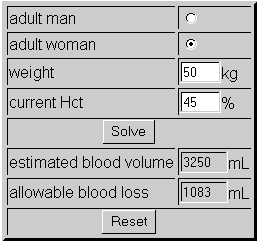|
|
|
 |
calculate allowable blood loss |
|
Formulas
Allowable Blood Loss (ABL)*
Hi = initial Hct |
Estimated Blood Volume (EBV)
EBV = weight (kg) x average blood volume |
Average blood volumes** | |
Age |
Blood volume |
| Premature Neonates | 95 mL/kg |
| Full Term Neonates | 85 mL/kg |
| Infants | 80 mL/kg |
| Adult Men | 75 mL/kg |
| Adult Women | 65 mL/kg |
| Men | 42-52% |
| Women | 37-47% |
If the patient is obese, using the IBW or ABW will give more accuracy than an actual weight.
Example
Question: Before surgery is to take place, what is the estimated blood volume (EBV) of a female patient weighing 50 kg? Also, what is the allowable blood loss (ABL) of this patient if her Hct is 45?

In the example above, EBV = 50kg x 65 (adult woman's blood volume)
= 3250
The initial Hct (Hi) = 45%, her current Hct
The final lowest
acceptable Hct (Hf) = 30% (What ever cut off is used clinically to decide how
low the individual's Hct will be allowed to drop. Thirty percent is used
in this calculator but in reality this will vary from case to case.)
So
the example would look like this:
|
3250 x (45 - 30) |
= 1083 |
Using this rough estimate, the patient in this example could loose 1083 mL of blood without needing a transfusion.
Replacing Blood Loss
"Ideally, blood loss should be replaced with crystalloid or colloid solutions to maintain intravascular volume (normovolemia) until the danger of anemia outweighs the risks of transfusion. At that point, further blood loss is replaced with transfusions of red blood cells to maintain hemoglobin concentration (or hematocrit) at that level. For most patients, that point corresponds to a hemoglobin between 7 and 10 g/dL (or a hematocrit of 21-30%). Below a hemoglobin concentration of 7 g/dL, the resting cardiac output has to increase greatly to maintain normal oxygen delivery" (Morgan & Mikhail, 1996).
Estimating blood loss***
Dry sponges
4x4 hold ~ 10 mL blood
Ray-techs ~ 10-20 mL blood
Lap sponges ~ 100 mL blood
Pediatric cases should have sponges & gauze weighed for blood loss**
Blood loss replacement***
Replace 1 mL blood with:
3 mL crystalloid (i.e. NS, Dextrose, LR)
1 mL colloid (i.e. albumin**, Hespan®, Dextran®)
1 mL whole blood
1 mL PRBC
*Miller (2000).
**Morgan & Mikhail
(1996).
***Naglehout, Zaglaniczy & Haglund (2001).
________________________
Copy Right 2008-2009
J.U.S.T - Faculty of Nursing